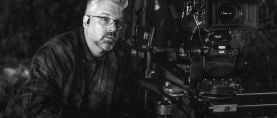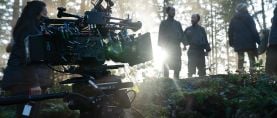
8 ASC Cinematographers Meet RIT Students
Recomposing shots in post, prepping a TV series properly, and collaborating with directors, actors and production designers were just a few of the topics discussed when students from the Rochester Institute of Technology.

Recomposing shots in post, prepping a TV series properly, and collaborating with directors, actors and production designers were just a few of the topics discussed when students from the Rochester Institute of Technology recently visited the Clubhouse to meet with a panel of ASC cinematographers.
Volunteering their time for the event were Bill Bennett, Christopher Chomyn, George Spiro Dibie, David Klein, Don McCuaig, Cynthia Pusheck, John Simmons and Lisa Wiegand. Bennett is a top commercial cinematographer who will receive this year’s ASC Presidents Award; Chomyn recently shot The Three-Body Problem in China; Klein recently wrapped his second season of Homeland; McCuaig is a second-unit cinematographer with extensive experience in film and television; Pusheck was the director of photography on the series Revenge and Brothers & Sisters; Simmons’ credits include the series Men at Work and Good Luck Charlie; and Wiegand was most recently behind the camera on the new season of American Crime.
Dibie, who chairs the ASC Education & Public Outreach Committee, kicked off the discussion by noting that sharing information and educating others about the cinematographer’s craft has always been critical to the ASC’s mission.
Here are excerpts from the conversation:
Is learning how to shoot film still worth it?
Bill Bennett, ASC: Most of my work is making TV commercials, and I’ve owned a long succession of film cameras. About four years ago, the agencies decided they liked the speed of postproduction you could get with digital. I bought an Alexa, and over time I stopped using my film cameras, so much so that I donated them to the ASC’s camera collection. But no sooner did I do that, than someone called me up, wanting me to shoot a commercial with film. Now I’m borrowing them back from the ASC! So, never say never.
David Klein, ASC: The sad part is filmmakers didn’t make the decision not to shoot film; it was made for us. There isn’t anyone [on this panel] who wouldn’t rather be shooting film. I shot film on True Blood for every season but the last one, when production decided to go digital so they could bring post and dailies in-house. Once you do that — bring post and dailies in-house — you can save $1 million over the course of 12 episodes.
Chris Chomyn, ASC: The move to digital in TV really happened because of the actors’ [Screen Actors Guild] strike in 2008. Pilot season came around during the strike, and the producers went with AFTRA [American Federation of Television and Radio Artists, a separate union at the time] and had to shoot everything digitally. TV quickly moved into a digital world, and that changed the economy of the business.
Tell us about your relationship with directors.
Chomyn: It’s like a marriage: What you do is what they allow you to do, and what they push you to do. Ideally, it’s a relationship that grows over time.
Don McCuaig, ASC: The cinematographer is the director’s pal. And here’s a tip for you young cinematographers: Team up with directors who are younger than you are. If you don’t, as you get into your 50s and still want to shoot, you’ll find your directors are retiring.
John Simmons, ASC: It’s all about collaboration. Every director is different, and the approach they have to cinematography is different.
Bennett: The best directors push you outside your comfort zone. But if you work in commercials, as many people do, you have to be aware that there’s more than one master. On a feature film, the director has final say. On a commercial, the agency and also the client have final say. There’s a lot of diplomacy and tiptoeing involved.
Lisa Wiegand, ASC: When I’m shooting a TV show, my job is to make sure the director stays within the style of the show. That can be fun or painful. When I was in film school, none of my instructors really expressed how much of my job would be political versus creative.
What’s your relationship with actors like?
McCuaig: Dealing with actors — and not just making cool shots — is one of the most important aspects of what we do. It’s important to guide your actors and give them confidence.
Klein: And they’re all different. When I started shooting True Blood, Anna Paquin sat down with me to discuss how she prefers to be lit. She was convinced she just didn’t look good in half-light, so there always had to be something frontal on her, even if it was something really small just over the camera. When I came onto Homeland, I made a point of sitting down with Claire Danes to ask her what she prefers, and she said, ‘David, I have no idea how you do what you do. I’ll leave it to you.’
What do you do if your director tells you not to talk to the actors?
George Spiro Dibie, ASC: The worst thing you can do is approach an actor directly if you have a problem [with something they’re doing]. You could be fired.
Chomyn: On the first day of a show, if the actor isn’t on the mark, I’ll ask the director to put her on the mark. If the director says, ‘You tell her,’ then I’ll assume I have that permission for the rest of the show.
Wiegand: I establish close relationships with actors on TV series, partly because the directors usually come in as guests. Recently, a director came in that the actors were unhappy with, and I got a midnight call from an actor, asking why something had been blocked a certain way and asking if I could effect a reshoot of the scene. I find that the actors will come to me if they don’t know the director. I have to be careful about working through the politics of that.
As cinematographers, what are the qualities you want in a director?
Cynthia Pusheck, ASC: The directors who come in prepared and are collaborative and respectful of the crew are the ones who get the best out of everybody. I also love working with tough directors who are passionate and push everyone. So, for me, it’s a combination. Directors are as different as we are; there is not just one kind of good director.

When can you say ‘No’ to a director?
Simmons: When I was a camera assistant, I once overheard the cinematographer talking to the director and saying ‘No.’ The director’s demeanor didn’t change at all, but he walked over to the producer and said, ‘I need a new cinematographer. I can’t work with one who says no.’ That was something I knew I’d remember.
Chomyn: Instead of saying ‘No,’ I’ll usually say, ‘Okay, we can do that, but there will be these consequences …’ and then explain how that will impact the other things we have to consider.
How does your preproduction process differ on features versus TV?
Dibie: The preproduction process on TV series is a lot better if there are alternating cinematographers instead of just one. But now, because of budgets, very few shows do that.
Pusheck: It saves production a lot of money when you can alternate cinematographers. When I was the alternating cinematographer on a series, I’d get four days off, four to prep and eight to shoot. When I was the sole cinematographer, I found I was often prepping on my own time.
Wiegand: I’ve done something on my last two shows that works well: I try to have an operator or second-unit cinematographer shoot on my tech-scout days, and I’ll go on the tech scout to make sure we’re ordering the necessary gear. Going on the tech scout helps a lot. If you’re on the set and someone else does the tech scout, they show you pictures and maps while your brain is totally occupied with what’s going on in front of you. And pictures don’t tell you what’s around the corner.
What is your collaboration like with production designer?
Klein: We have a great one on Homeland, John Kretschmer, and nine times out of 10 we are on the same page. This last season, which was set in Berlin, he fell in love with white walls, which are very typical of design in Berlin. I finally said, ‘What’s with the white walls? They’re killing me!’ So he made some changes. We’re friends by now, so our conversations are open and easy. We have a constant dialogue; it’s a collaboration.
Dibie: When you’re meeting with a production designer for the first time, be sure to ask for windows, ask for sources. And make sure there is color.
What do you look for in camera operators?
Dibie: I always looked for someone who started as an assistant and then moved up.
Pusheck: A good operator listens, is good at composition, and works well with other operators. The best operator pays attention to dialogue and listens to the director’s notes.
How do you protect your work in post?
Klein: Don't turn in shots you don’t want them to use!
McCuaig: If you have a good overall understanding of what filmmaking is about, then you can have more of a say in the post process.
Wiegand: I try to establish a close relationship with everyone in post early on, and I show them a lot of visual references.
Pusheck: A lot of TV shows won’t let you have a DIT [digital-imaging technician] on set. In those situations, I try to have eight or 10 LUTs [look-up tables] we can punch in so the dailies go out looking close to what I want for the final image.
A current trend in cinematography is to shoot high resolutions to create the ability to recompose shots in post. How often are your compositions changed this way?
Wiegand: It happens all the time in TV. When I started asking for EDLs of the reframes, I got a list that showed frame after frame after frame. I found myself wondering, why do I even have an operator if they’re just going to reframe everything? Once, on an over-the-shoulder, they decided they didn’t like what the person in the foreground was doing, and they just swapped in another image.
Pusheck: It’s especially frustrating when you spend a lot of time making an actor’s close-up look good, only to have them replace it with a medium shot and just push in. The cinematographer may be the one who has to answer for that. Scary!





